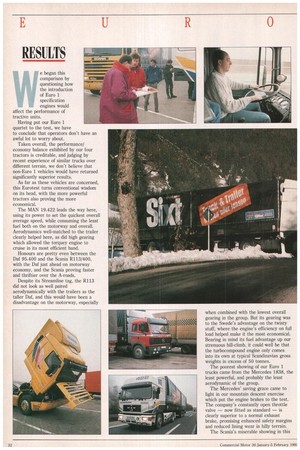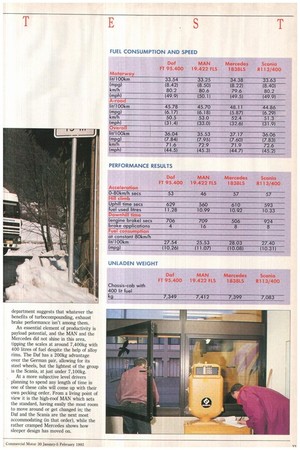RESULTS
Page 34

Page 35

If you've noticed an error in this article please click here to report it so we can fix it.
e began this comparison by
VV ' — questioning how the introduction of Euro 1 specification engines would affect the performance of tractive units.
Having put our Euro 1 quartet to the test, we have to conclude that operators don't have an awful lot to worry about.
Taken overall, the performance/ economy balance exhibited by our four tractors is creditable, and judging by recent experience of similar trucks over different terrain, we don't believe that non-Euro 1 vehicles would have returned significantly superior results.
As far as these vehicles are concerned, this Eurotest turns conventional wisdom on its head, with the more powerful tractors also proving the more economical.
The MAN 19.422 leads the way here, using its power to set the quickest overall average speed, while consuming the least fuel both on the motorway and overall. Aerodynamics well-matched to the trailer clearly helped here, as did high gearing which allowed the torquey engine to cruise in its most efficient band.
Honours are pretty even between the Daf 95.400 and the Scanii R113/400, with the Daf just ahead on motorway economy, and the Scania proving faster and thriftier over the A-roads.
Despite its Streamline tag, the R113 did not look as well paired aerodynamically with the trailers as the taller Daf, and this would have been a disadvantage on the motorway, especially
when combined with the lowest overall gearing in the group. But its gearing was to the Swede's advantage on the twisty stuff, where the engine's efficiency on full load helped make it the most economical. Bearing in mind its fuel advantage up our strenuous hill-climb, it could well be that the turbocompound engine only comes into its own at typical Scandinavian gross weights in excess of 50 tonnes.
The poorest showing of our Euro 1 trucks came from the Mercedes 1838, the least powerful, and probably the least aerodynamic of the group.
The Mercedes' saving grace came to light in our mountain descent exercise which put the engine brakes to the test. The company's constantly open throttle valve — now fitted as standard — is clearly superior to a normal exhaust brake, promising enhanced safety margins and reduced lining wear in hilly terrain. The Scania's miserable showing in this department suggests that whatever the benefits of turbocompounding, exhaust brake performance isn't among them.
An essential element of productivity is payload potential, and the MAN and the Mercedes did not shine in this area, tipping the scales at around 7,400kg with 400 litres of fuel despite the help of alloy rims. The Daf has a 200kg advantage over the German pair, allowing for its steel wheels, but the lightest of the group is the Scania, at just under 7,100kg.
At a more subjective level drivers planning to spend any length of time in one of these cabs will come up with their own pecking order. From a living point of view it is the high-roof MAN which sets the standard, having easily the most room to move around or get changed in; the Daf and the Scania are the next most accommodating (in that order), while the rather cramped Mercedes shows how sleeper design has moved on.
















































































